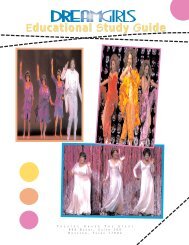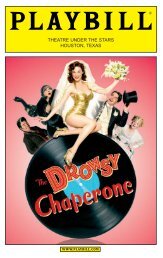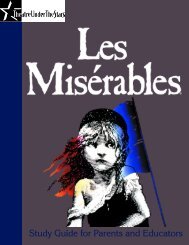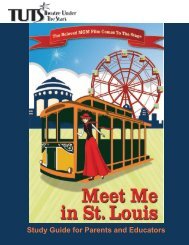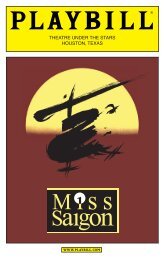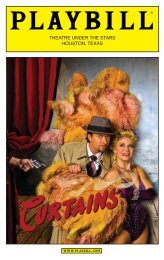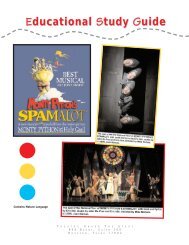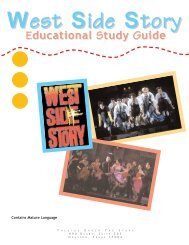The Drowsy Chaperone Study Guide - Theatre Under The Stars
The Drowsy Chaperone Study Guide - Theatre Under The Stars
The Drowsy Chaperone Study Guide - Theatre Under The Stars
You also want an ePaper? Increase the reach of your titles
YUMPU automatically turns print PDFs into web optimized ePapers that Google loves.
TEXTS<br />
<strong>The</strong> Musical: A Look at the American Musical <strong>The</strong>ater by Richard Kislan (Applause, 2000)<br />
Facets of Comedy by Walter Sorrell (Grosset & Dunlap, 1972)<br />
How to Be Funny: Discovering the Comic You by Steve Allen (Prometheus, 1998)<br />
Made You Laugh: <strong>The</strong> Funniest Moments in Comedy (Hardcover) by Joe Garner (Andrews McMeel , 2004)<br />
VIDEO OR DVD<br />
Steamboat Bill, Jr. (1928) Directed by Charles Reisner (Image Entertainment, 1999)<br />
Modern Times (1936) Directed by Charles Chaplin (Warner Home Video, 2003)<br />
<strong>The</strong> Harold Lloyd Comedy Collection (New Line, 2005)<br />
RECORDINGS<br />
<strong>The</strong> <strong>Drowsy</strong> <strong>Chaperone</strong> Original Broadway Cast Album (Ghostlight, 2006)<br />
Goals:<br />
· LANGUAGE ARTS: Uses a variety of prewriting strategies<br />
(e.g. develops a focus, plans a sequence of ideas, uses<br />
structured overviews, uses speed writing (brainstorming),<br />
creates diagrams)<br />
· LANGUAGE ARTS: Uses reading skills and strategies to<br />
understand a variety of literary texts (e.g., fiction,<br />
nonfiction, myths, poems, biographies, autobiographies,<br />
science fiction, supernatural tales, satires, parodies, plays,<br />
American literature, British literature, world and ancient<br />
literature)<br />
· LANGUAGE ARTS: <strong>Under</strong>stands how literary forms can<br />
be represented in visual narratives (e.g., allegory, parable,<br />
analogy, satire, narrative style, characterization, irony)<br />
· HISTORY: Analyzes the values held by specific people<br />
who influenced history and the role their values played<br />
in influencing history<br />
· HISTORY: Analyzes the influences, specific ideas and<br />
beliefs had on a period of history and how events might<br />
have been different in the absence of those ideas and<br />
values<br />
21<br />
· THEATRE: <strong>Under</strong>stands the basic physical and chemical<br />
properties of the technical aspects of theatre (e.g. light,<br />
color, electricity, paint, makeup)<br />
· THEATRE: <strong>Under</strong>stands production requirements for a<br />
variety of dramatic texts from cultural and historical<br />
perspectives<br />
· THEATRE: Improvises, writes, and refines scripts based<br />
on personal experience and heritage, imagination,<br />
literature and history<br />
· THEATRE: Conceptualizes and realizes artistic<br />
interpretations for informal or formal productions<br />
· MUSIC: <strong>Under</strong>stands characteristics that cause various<br />
musical works (e.g. from different genres, styles, historical<br />
periods, composers) to be considered exemplary<br />
· MUSIC: Classifies unfamiliar but representative aural<br />
examples of music (e.g. by genre, style, historical period,<br />
culture)<br />
· MUSIC: Knows sources of American music genres (e.g.<br />
swing, Broadway musical, rock), the evolution of these<br />
genres, and the musicians associated with them



